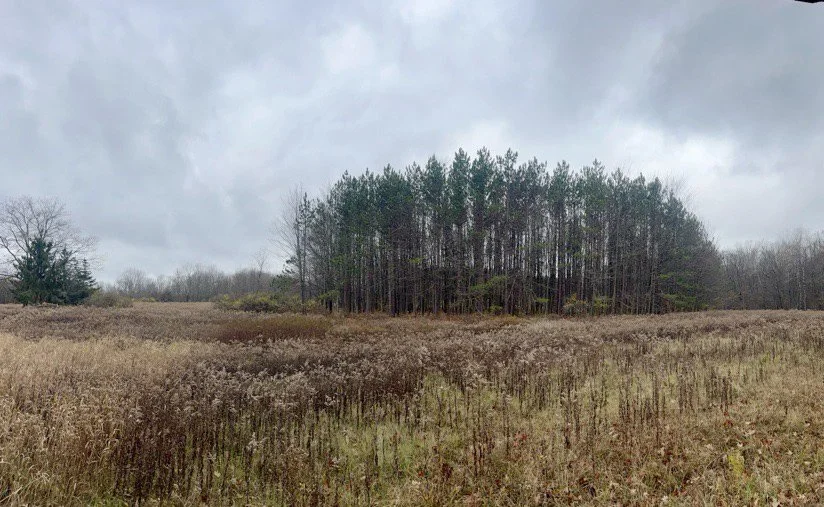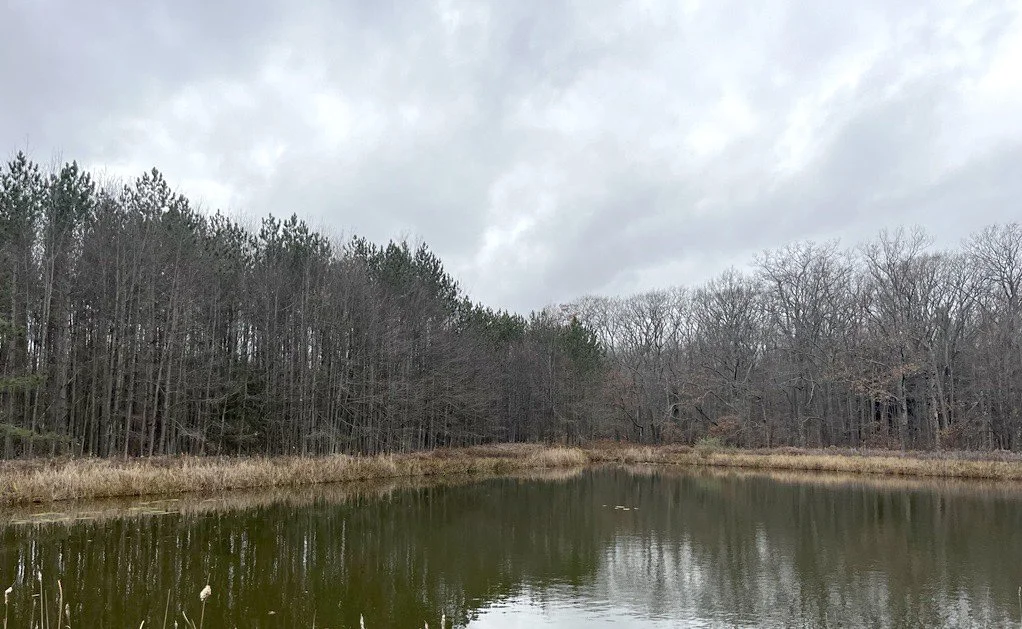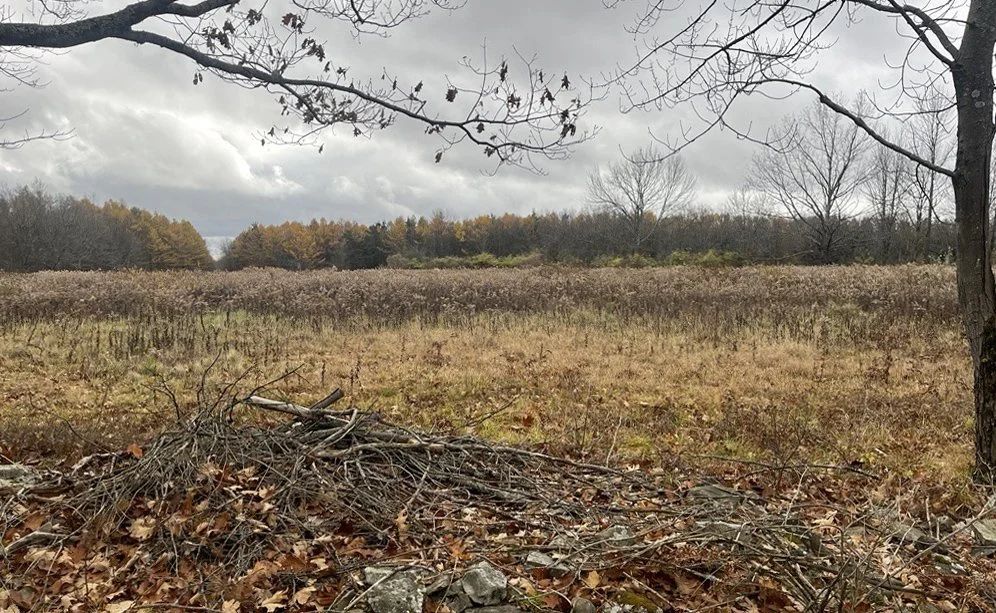Land Purchase to Enhance Rattle Snake Hill Wildlife Management Area
Genesee Valley Conservancy is thrilled to announce the purchase of 95 acres of field and forest habitat to enhance Rattlesnake Hill Wildlife Management Area.
The acquisition is part of the Conservancy’s cooperative conservation program, focused on acquiring critical pieces of land to fill-in and connect existing conservation areas.
Rattlesnake Hill is a conservation area owned by New York State Department of Environmental Conservation for the purpose of providing quality habitat for the benefit of wildlife and for recreational pursuits such as hunting, trapping, fishing, and watching.
The Acquisition
The 95-acre land purchase is split between two parcels. The northern parcel lays within the Wildlife Management Area entirely surrounded by State owned and Allegany County owned forest land, filling in a significant ‘donut-hole’ area. The southern parcel adjoins the wildlife area directly on its southern border and is across the road from additional conservation area.
The lands acquired are along English Hill Road, a dirt roadway that quickly ascends from Route 70 just south of Swain, as it travels up into the forestland composing Rattlesnake Hill. Around 75% of the lands acquired are forested, a mix of conifer stands and hardwood species. The remaining 25% is primarily grasslands. The previous owner took great care to manage and maintain the fields for wildlife use, in particular grassland birds, species that rely on such open habitats for nesting and feeding. A pond and small creek area are also on the acquired land.
This project will expand and enhance recreational resources, visitor access, and wildlife habitat to Rattlesnake Hill once the land can be transferred into State ownership and become part of the Wildlife Management Area.
Wildlife
The parcel is located in western New York on the northern Allegheny Plateau, and features mammals typical of the area. Gray and red squirrel, white-tailed deer, raccoon, red and gray fox, coyote, opossum, and black bear are quite common at Rattlesnake Hill. The Wildlife Area’s name comes from the timber rattlesnake, which has historically been found in the more remote places in the area.
As populations of bobcat and fisher are increasing across New York State, sightings of these species have become more frequent here too.
Rattlesnake Hill also has numerous amphibian and reptile species, including painted and snapping turtle, garter and milk snake, red-spotted newt, and vernal pool breeders such as wood frog and spotted salamander.
This parcel adds more open field habitat into this management unit, as well as a pond, which will continue to contribute to the diversity of this areas ecological importance.
History
This acquisition was made possible via a purchase by Genesee Valley Conservancy from the previous landowner, William (Bill) Maracle of Dansville. The sale by Bill helped him achieve his desired conclusion to owning this land: ensuring it remained valued open space and could be enjoyed by and benefit the community.
Bill purchased the land in 1969 with a friend and partner Steve Rauber of Ossian, New York for $1,200 each or $25/acre. At the time, Bill and Steve had an interest in hunting. They bought the land when it came up for sale by a farmer who had been growing corn and potatoes there. After spending time getting to know the land, their interests shifted from hunting to a love of trees and wildlife.
They hired a forester who came out and instructed them to remove much of the red-maple that had dominated the basal area. Bill and Steve decided to purchase a horse drawn mower to keep some of the grasslands maintained for habitat and then hired a logger who removed the red-maple.
As part of the logging contract, they required that the timer be removed using horses. Bill recalls how impressive it was admiring a team of horses using timber arches to pull massive logs out of the woods. After the maple was removed, Bill and Steve planted around 1,000 red pine trees that exist today in an impressive conifer stand.
Bill recalls watching how beautifully the forest responded to the timber stand improvements they performed over the decades, noting how providing a little space to the dominant and desired species created a much healthier forest ecology. One of his favorite memories was broadcasting buckwheat by hand in one of the northern fields as an experiment and then seeing how the bees and deer responded with joy.
The acquisition was made not by an outright purchase, but thanks to a mortgage Maracle is holding for the Conservancy, allowing the Conservancy to put forth only a down payment and schedule modest monthly payments as the organization works to transfer the lands to NYS raise funds to help support the transaction. This advantageous way to manage cash flow for the Conservancy will allow the organization to continue to pursue other projects simultaneously.
By selling this land to the Conservancy, Bill sought to ensure the habitat he had worked for so long to maintain and improve would not be lost to development or exploitation, and that the land would become available for the public to enjoy in the ways he has for over half a century. By selling this property in his lifetime, Bill can see and appreciate this next phase on this land he loves at time when he is ready to pull back from his trips up English Hill and the hours of maintenance and habitat management.
Cooperative Conservation
The Conservancy’s cooperative conservation program used to acquire this property is focused on in-filling and buffering existing public conservation areas to improve and enhance them.
The parcel’s location directly adjacent and within the Wildlife Management Area was an obvious choice for the cooperative conservation program, as ultimately transferring the land to New York State for permanent protection allows the State to implement one unified management plan in the area, an area where long-term Conservancy ownership and staff investment would be redundant to the efforts by NYS in managing and overseeing land surrounding this parcel.
Through accepting land donations or purchasing land outright, the Conservancy can work with landowners to acquire parcels of critical interest that fit within larger conservation goals and facilitate their transfer to State or other agencies best suited for long term management.
The Conservancy’s local connections and presence in the Genesee Valley helps the organization identify and foster cooperative conservation deals like this. The Conservancy then works through the lengthy and complex process of transferring land to the State, which requires working with the local town, the regional State office, and State officials in Albany – not something most individual landowners would be able or interested in trying to do alone.
Next Steps
The Conservancy will use an interim management plan to manage this property over the next year or two, primarily keeping it in its current condition, as staff work to transfer this property to NYS-Department of Environmental Conservation ownership.
The State has strict standards for land acquisition and there are various steps and reviews that need to take place before the State will be willing to accept this property from the Conservancy.
How to Help
This project was made possible in part by the organization’s Acquisition Fund, a critical reserve which is allowing the organization to purchase parcels (and/or make down payments) on properties like this. The Conservancy is working to grow this fund to allow more and larger cooperative conservation projects to take place simultaneously. Acquiring critical conservation properties is a costly endeavor requiring staff time, legal assistance, property surveys, title review. Individual and foundation support of the Conservancy can help continue and enhance this program so existing conservation areas can be enhanced and unified.
Summary
This conservation project was the 3rd in the town of Grove by the Conservancy and the first cooperative conservation protect undertaken there. It was supported by the Grove Town Board.
This project was the result of a collaboration between Genesee Valley Conservancy, Town of Grove, landowner William (Bill) Maracle, and New York State Department of Environmental Conservation.
To-date, the Genesee Valley Conservancy has secured six parcels of land totaling 277 acres as part of its cooperative conservation program; acres that will be merged into New York State Parks and Wildlife Management Areas in the Genesee Valley to enhance existing conservation areas.
Genesee Valley Conservancy works throughout the Genesee River watershed to protect high quality habitat, open space and farmland for the community. The Conservancy now oversees the protection of 36,340 acres.
Landowners in the Genesee River watershed interested in pursuing conservation options for their property should contact Genesee Valley Conservancy for more information.
###
Genesee Valley Conservancy is a nationally accredited non-profit conservation organization working to protect the habitat, open space and farmland in the Genesee River watershed. Over 36,340 acres of natural habitat and productive farm and forest land have been conserved by Genesee Valley Conservancy in partnership with private landowners. The organization also owns nature preserves open to the public for recreation and education. For more information visit www.geneseevalleyconservancy.org




